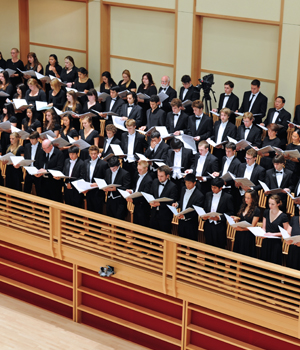
NEW CONDUCTOR EARNING HIS SPURS FAST
ROHNERT PARK, CA—The unfinished Mozart Requiem got a refined performance, deserving of both the sellouts and the ensuing ovations. Clearly, in this first year leading the Santa Rosa Symphony, Francesco Lecce-Chong is fast earning his spurs as music director, exhibiting his finesse and his deft 18th-century styling. For once we avoided the excess romanticization encountered so often. The emphasis was clearly on clarity and articulation, achieved best with the instrumentalists. (The otherwise effective massed chorus of 75 or so singing in Latin could still use a few more pointers. Like most, they neglect diction, perhaps misled by that renowned San Francisco chorus winning multiple Grammies despite consonants so mushy, almost impossible to follow, even with a printed text.)
This was our first encounter with the “Requiem” completion done by Mozart scholar/musicologist Robert Levin. His work was an improvement over the old Süssmayr completion, particularly in the orchestral segments.
In this opus many of us simply lose it in the eloquent “Lacrimosa” section of the score, broken off at the end of the chorus’ rising modulating scale, the point where the dying Mozart wrote his very last musical note.
Legend had the Requiem to be diabolical, with the commission given poor Mozart by the spectre Satan himself, who knew well Mozart’s fascination with Hell, (recall the “Don Giovanni” finale). Overheard at intermission: “Let’s hope when it’s all over we don’t all get dragged off to the hellfires.”
No, this one was more celestially focused. Whenever the (underworldly?) basses rumble in at the “Confutatis,” angelic women’s voices retort “kneeling in supplication (for mercy).” But, in contrasting images of Heaven and Hell, Mozart was anticipating the romantic era that evolved a decade or so later.
If Mozart had not actually completed all the vocal lines, at least Levin hewed to the vocal score of Mozart-Süssmayr. “Requiem” completions after Süssmayr have had to produce the orchestral score for the last four (of eight) sections: Sanctus, Benedictus, Agnus Dei and Communio(n). And the interwoven soloists’ quartet of the “Benedictus” was surely one of Mozart’s supreme late-life achievements.
The two lady soloists (Shawnette Sulker, Laura Krumm) were elegant and evocative. The rock-ribbed foundation was provided by the remarkable, unsinkable veteran Bay Area basso Philip Skinner. The choristers represented the Santa Rosa Symphony Chorus as well as the SRJC Chamber Singers, combined.
The Dec. 8 concert opened with Haydn’s early Symphony No. 39, in which Lecce-Chong conducted while playing the keyboard accompaniment on fortepiano—that delicate and barely audible forerunner of the modern piano.
Jessie Montgomery’s “Records from a Vanishing City” (2016) furnished a 14-minute atmospheric city scene reflecting her New York City home. The piece bears some resemblance to Aaron Copland’s “Quiet City.” Montgomery however requires solos from all over the orchestra: oboe, French horn, and, with jazzy digressions, muted trumpet and a clarinet glissando. Her most original touch was weaving a very soothing Angola lullaby through the opus.
MUSIC NOTES—To prevent the waves of applause for an entering maestro and to establish the solemnity of the Requiem mass for the dead, Lecce-Chong took the stage in dark attire and facing upstage, as if he were a stagehand. And he forewent the customary podium in his low-key approach to a great great work.
SANTA ROSA SYMPHONY AND CHORUSES, Francesco Lecce-Chong music director. Mozart-Levin “Requiem,” other works, Dec. 7-9. Weill Hall, Sonoma State Univ., Rohnert Park, CA. For SRS info: (707) 546-8742 or go online: www.srsymphony.org.